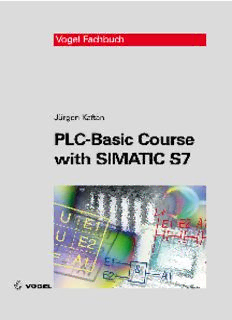Table Of ContentJürgen Kaftan
PLC Basic Course
with SIMATIC S7
Jürgen Kaftan
PLC Basic Course
with SIMATIC S7
Structure and Function of
Programmable Logic Controllers,
Programming with the SIMATIC S7
First Edition
JürgenKaftan
1967-1971 Apprenticeshipasanelectrician
1971-1973 Skilledtradesmaninthetradeofelectrician
1973-1975 Trainingasastate-certifiedelectricalengineer
1975-1977 Employedasatechnician
1977-1978 Schoolformastercraftsmen,graduatedasmasterelectrician
1979-1992 Nurembergvocationaltrainingcentreforhearingand
speechimpairedpersons,MasterTrainer
1985-1992 CourseLeaderforPLCsinvocationaltraining(BFH)forhearing
andspeechimpairedpersons
1985-1992 CourseLeaderforPLCsattheChamberofCrafts
1992-1995 IKHElektrogerätebau–SystemTrainingCourses
(ManagingDirector)
Since1995 ManagerofIHKSystemschulungenforHardwareandSoftware
(ChamberofIndustryandCommercehardwareandsoftware
systemtrainingcourses)inWeißenburgandRoth
(CentralFranconia)
JürgenKaftanistheauthorofthefollowingreferencebookspublishedbyVogel:
PLCBasicCourse1
PLCBasicCourse2
PLCBasicCoursewithSIMATICS7
ThebookincludesaSiemensAGdemonstrationCD-ROM»STEP7Professional,Edition2004
SR4,TrialLicense«including:STEP7V5.3SP3,S7-GRAPHV5.3SP2,S7-SCLV5.3SP1,S7-
PLCSIMV5.3SP1andcanbeusedfortestpurposesfor14days.
ThesoftwareonlyrunsunderWindows2000ProfessionalSP4andaboveorWindowsXPPro-
fessionalSP1andabove.
ForfurtherinformationontheInternet,visit www.siemens.de/sce/promotoren.
Furtherinformation:
www.vogel-buchverlag.de
ISBN978-3-8343-3201-1
FirstEdition2011
Allrightsreservedincludingtranslation.Nopartofthisworkmaybe
reproduced,processedusinganytypeofelectronicsystem,duplicated
ortransmittedinanywayorinanyform(printing,photocopying,mi-
crofilmorusinganyotherprocess)withouttheexpresswrittencon-
sentofthepublisher.TheexceptionsstatedexpresslyinPara.53,54of
theGermanCopyrightActarenotaffected.
PrintedinGermany
Copyright1998byVogelIndustrieMedienGmbH&Co.KG,
Würzburg
Bookjacketillustration:MichaelM.Kappenstein,Frankfurt
Foreword
Programmablelogiccontrollers,knownforshortasPLCs,areanintegralpartof
automation at the lower, middle and upper performance levels. Due to the ever
increasingsizeandcomplexityofthehardwareandsoftwarerequiredinautoma-
tion projects, the industry has had to develop faster, more capable and effective
automation systems and to simplify handling for users. All the exercises in this
book have been developed and tested using Siemens' SIMATIC S7-300 PLC.The
command set of this controller ranges from binary processing to 32-bit floating
pointarithmetic.ThecontrollerisprogrammedundertheWindowsXPoperating
system and it is assumed that users have an appropriate basic knowledge.All the
procedures for programming the SIMATIC S7-300 are demonstrated exactly and
are easy to understand for users.The topic builds up from "easy to hard" and is
ideally suited for use in vocational and technical training colleges,etc.as well as
foruseonateach-yourselfbasis.
IwouldliketothanktheWükro-LehrsystemecompanyinWürzburgaswellas
everybodywhohashelpedinthecompletionofthisbook.Iamalwaysgratefulto
receivefeedbackfromreadersandusers.
Weißenburg/Heuberg(CentralFranconia) JürgenKaftan
5
6
Contents
Foreword....................................................................................................... 5
1 Introduction.................................................................................... 13
1.1 Numbersystem............................................................................... 13
1.2.2 Byte................................................................................................. 14
1.2.3 Word............................................................................................... 14
1.2 Termsfromcomputerscience.......................................................... 14
1.2.1 Bit................................................................................................... 14
1.2.4 Bitaddress....................................................................................... 15
1.2.5 Byteaddress.................................................................................... 15
1.2.6 Wordaddress.................................................................................. 15
2 ArrangementofaPLC..................................................................... 17
2.1 StructureofaPLC........................................................................... 18
2.2 Structureofanautomationunit...................................................... 18
2.3 Hardwarerequirements................................................................... 18
2.3.1 Hardwarestructure......................................................................... 20
2.4 Softwarerequirements..................................................................... 20
2.4.1 STEP7programminglanguage....................................................... 20
2.4.2 Objects............................................................................................ 20
2.4.3 Projects........................................................................................... 21
2.4.4 ConfiguringanS7-300.................................................................... 22
2.4.5 Parameterization............................................................................. 22
3 WayofFunctioningofaPLC.......................................................... 23
3.1 ModulesofthePLC........................................................................ 23
3.1.1 Powersupplyunit........................................................................... 23
3.1.2 Programmemory............................................................................ 24
3.1.3 Centralprocessingunit(CPU)......................................................... 25
3.1.4 Bussystem....................................................................................... 27
3.1.5 Inputandoutputmodules............................................................... 27
4 ProgramProcessingandProgramming............................................ 29
4.1 Linearprogramprocessing.............................................................. 29
4.2 Structuredprogramming................................................................. 30
4.3 Controlinstruction.......................................................................... 31
4.3.1 Operationpart................................................................................ 32
7
4.3.2 Examplesfordigitaloperations....................................................... 32
4.3.3 Examplesofbinaryoperations........................................................ 32
4.3.4 Examplesoforganizationaloperations............................................ 33
4.3.5 Operandpart.................................................................................. 33
4.4 Addressing...................................................................................... 34
4.4.1 SymbolicAddressing....................................................................... 34
4.4.2 Absoluteaddressing........................................................................ 34
4.4.3 Immediateaddressing...................................................................... 34
4.4.3.1 Directaddressing............................................................................. 34
4.4.3.2 Memory-indirectaddressing............................................................ 35
4.5 Programrepresentation................................................................... 35
4.5.1 Ladderdiagram(LAD).................................................................... 36
4.5.2 FunctionblockdiagramFBD(STEP7V3.xandabove).................. 36
4.5.3 StatementlistSTL........................................................................... 36
4.6 Flags................................................................................................ 37
4.6.1 Retentiveflags................................................................................. 37
4.6.2 Non-retentiveflags.......................................................................... 38
5 Logicoperations.............................................................................. 39
5.1 Basiclogicoperations...................................................................... 39
5.1.1 ClearingtheCPU............................................................................ 40
5.1.2 Creatingprojects............................................................................. 42
5.1.3 InsertingtheSIMATIC300station.................................................. 43
5.1.4 Configuringandparameterizing...................................................... 43
5.1.5 Arrangementofthepowersupply................................................... 45
5.1.6 ArrangementoftheCPU314.......................................................... 46
5.1.7 Arrangementoftheinputmodule................................................... 46
5.1.8 Arrangementoftheoutputmodule................................................. 47
5.1.9 ParameterizingtheCPU314........................................................... 47
5.1.10 Savingtheglobalconfiguration....................................................... 49
5.1.11 TransferringtheconfigurationtotheCPU...................................... 49
5.2 LogicalANDoperationuserprogram............................................. 50
5.2.1 EnteringFCs(FC1)........................................................................ 50
5.2.2 S7blockfunction............................................................................ 52
5.2.3 EnteringOB1................................................................................. 55
5.2.4 Downloading.................................................................................. 58
5.2.5 Testing............................................................................................. 59
5.2.6 Specifyingtriggerconditions........................................................... 60
5.2.7 DeactivatingtheFBDprogramstatus.............................................. 63
5.2.8 TestingwithSTL............................................................................. 63
5.2.9 TestingwithLAD............................................................................ 65
5.2.10 Extendingfromtwotothreeinputs(3rd.inputI0.2)....................... 67
5.2.10.1ExtendingwithSTL........................................................................ 67
8
5.2.10.2ExtendingwithLAD....................................................................... 69
5.2.10.3ExtendingwithFBD........................................................................ 71
5.2.11 Reducingfrom3inputsto2(deleteI0.2)........................................ 73
5.2.11.1ReducingwithSTL.......................................................................... 73
5.2.11.2ReducingwithLAD........................................................................ 74
5.2.11.3ReducingwithFBD......................................................................... 74
5.3 LogicalORoperationuserprogram................................................ 75
5.3.1 EnteringtheprogramusingthePC(FBD)....................................... 75
5.3.2 Createtheproject............................................................................ 76
5.3.3 CopySIMATICstation1intoanotherproject................................. 77
5.3.4 ChangeOB1................................................................................... 80
5.3.5 Downloading.................................................................................. 82
5.3.6 Testing............................................................................................. 82
6 ProgramInput................................................................................. 85
6.1 ANDbeforeOR.............................................................................. 85
6.2 ORbeforeAND.............................................................................. 88
6.3 Pollforsignalstate0....................................................................... 91
6.4 ExclusiveORoperation.................................................................. 94
6.5 Pollingoutputs................................................................................ 96
6.6 Insertingnetworks........................................................................... 98
6.7 LatchcircuitwiththePC................................................................. 101
6.8 PracticalexamplesofcontrolwiththePC....................................... 105
6.8.1 Temperaturedifference.................................................................... 105
6.8.2 Drinksmachine............................................................................... 106
6.8.3 Intercom.......................................................................................... 108
6.8.4 Generator........................................................................................ 110
6.8.5 Boilercontrol.................................................................................. 112
6.8.6 Smeltingfurnaces............................................................................ 113
6.9 Flip-flop.......................................................................................... 116
6.9.1 R-Sflip-flop..................................................................................... 116
6.9.2 Enteringtheprogram...................................................................... 118
6.9.3 Pumpcontroller.............................................................................. 122
7 CreatingMomentaryImpulses(EdgeInstructions).......................... 127
7.1 Momentaryimpulsewitharisingedge(FP).................................... 127
7.2 Momentaryimpulsewithafallingedge(FN).................................. 128
7.3 Programinput................................................................................. 128
7.4 Acknowledgementcircuit................................................................ 132
8 TimingFunctions............................................................................ 135
8.1 Timingvaluespecification............................................................... 135
8.2 Releaseatime(FR)......................................................................... 136
8.3 Currentvalue.................................................................................. 136
9
8.4 Resettime....................................................................................... 137
8.5 Selectionoftimes(fivedifferentones)............................................. 137
8.5.1 Pulsetimer(SP)............................................................................... 137
8.5.2 Extendedpulsetimer(SE)............................................................... 139
8.5.3 Switch-ondelaytimer(SD).............................................................. 140
8.5.4 Retentiveswitch-ondelaytimer(SS)............................................... 142
8.5.5 Switch-offdelaytimer(SF).............................................................. 143
8.6 PCprograminputoftimingfunctions............................................. 144
8.6.1 Garagelighting................................................................................ 147
8.6.2 Fillingsystem.................................................................................. 149
8.6.3 Compressorsystem......................................................................... 150
9 ClockGenerators............................................................................ 153
9.1 PCprograminputwithclockgenerator.......................................... 154
9.1.1 Channelswitch................................................................................ 156
9.1.2 Pagingsystem.................................................................................. 157
9.1.3 Airsupply....................................................................................... 159
10 Counters......................................................................................... 163
10.1 Loadandtransferfunctions............................................................ 163
10.2 Counterfunctions........................................................................... 164
10.2.1 Releaseacounter(FR).................................................................... 164
10.2.2 Countingforwards.......................................................................... 164
10.2.3 Countingbackwards....................................................................... 164
10.2.4 Setcounter...................................................................................... 165
10.2.5 Countvaluedefinition..................................................................... 165
10.2.6 Resetcounter(R)............................................................................ 165
10.2.7 Pollcountvalue(L/LC)................................................................... 165
10.2.8 Pollsignalstateofcounter(binary)................................................. 166
10.3 PCprograminputcleaningbath...................................................... 167
11 Comparators................................................................................... 169
11.1 Comparisonfunctions..................................................................... 169
11.1.1 Equalto==.................................................................................... 169
11.1.2 Notequal<>................................................................................... 170
11.1.3 Greaterthanequalto>=................................................................. 170
11.1.4 Greaterthan>................................................................................. 170
11.1.5 Lessthanequalto<=...................................................................... 170
11.1.6 Lessthan<...................................................................................... 171
11.2 PCprograminputrunwaylight....................................................... 171
11.3 Programinputsequencefunction.................................................... 174
12 PracticalExampleswithSimulators................................................. 177
12.1 Seven-segmentdisplay..................................................................... 177
12.2 Star-deltastarting............................................................................ 179
10
Description:This PLC-basic course explains the logic control with SIMATIC S7-300. For all programming examples from the practice, also a solution is provided. This book is suitable for trade schools, technical colleges and others, as well as for private study. It contains: Arrangement and functioning of a PLC P

